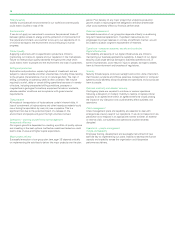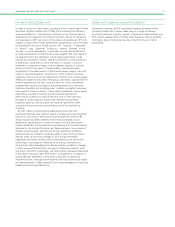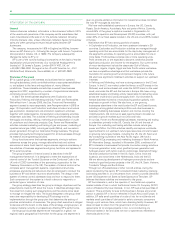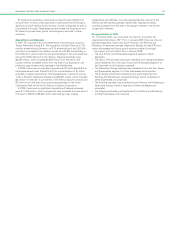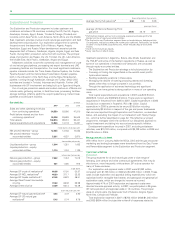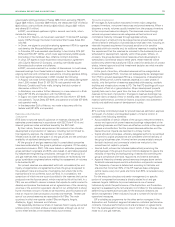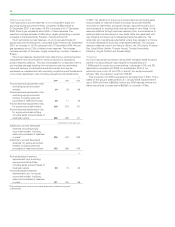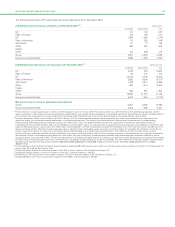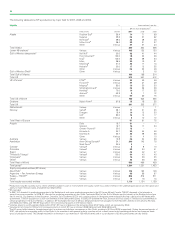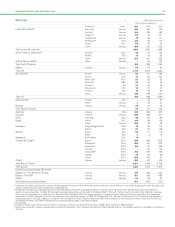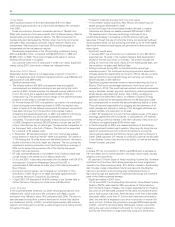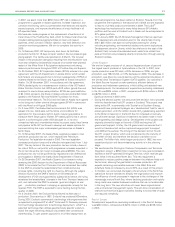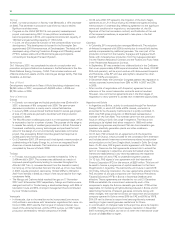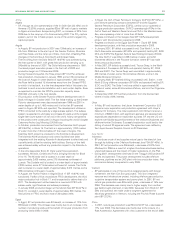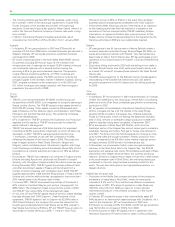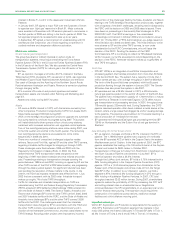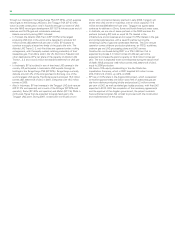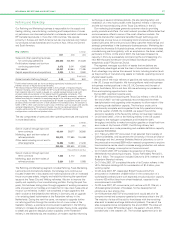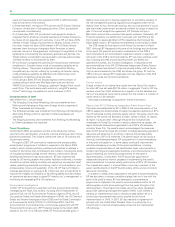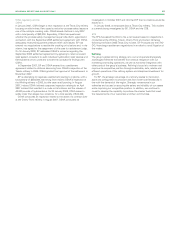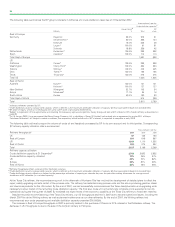BP 2007 Annual Report Download - page 22
Download and view the complete annual report
Please find page 22 of the 2007 BP annual report below. You can navigate through the pages in the report by either clicking on the pages listed below, or by using the keyword search tool below to find specific information within the annual report.
United States
2007 liquids production at 513mb/d decreased 6% from 2006,
while natural gas production at 2,174mmcf/d decreased 8% compared
with 2006.
Crude oil production showed a moderate decline of 18mb/d from
2006, with production from new projects (Gulf of Mexico) being offset by
divestments and natural reservoir decline. The NGLs component of
liquids production decreased by 15mb/d, driven mainly by commercial
changes in NGL processing contracts, natural reservoir decline and
divestments. Gas production was lower (201mmcf/d) because of
divestments and natural reservoir decline.
Development expenditure in the US (excluding midstream) during
2007 was $3,861 million, compared with $3,579 million in 2006 and
$2,965 million in 2005. The annual increase is the result of various
development projects in progress.
Our activities within the US take place in three main areas. Significant
events during 2007 within each of these are indicated below.
Deepwater Gulf of Mexico
Deepwater Gulf of Mexico is our largest area of growth in the US. In
2007, our deepwater Gulf of Mexico liquids production was 196mb/d and
gas production was 268mmcf/d.
Significant events were:
– The Atlantis platform (BP 56% and operator) was successfully
commissioned and started producing oil and gas during the fourth
quarter of 2007. Atlantis employs the deepest moored platform of its
kind in the world and a separate semi-submersible drilling and
construction rig. The versatile modular design of the platform provides
potential to add wells to increase recovery.
– At Thunder Horse (BP 75% and operator), as a result of a metallurgical
failure during pre-commissioning checks in 2006, the decision was
taken to repair all at-risk subsea components. All relevant components
have been removed from the sea floor and progress made in
reinstalling the repaired equipment. In 2007, the platform’s drilling rig
was commissioned and its first well successfully drilled and
completed. Thunder Horse is expected to start production by the end
of 2008. Designed to process 250,000 barrels of oil per day and 200
million cubic feet per day of natural gas, Thunder Horse is expected to
be the largest field in the Gulf of Mexico. The field will be supported
by a network of 25 subsea wells.
– In November, BP started production from two multi-phase subsea
pump stations in the King field (BP 100% and operator). At a depth of
1,700 metres and 15 miles away from the Marlin platform, this sets a
double world record for both depth and distance. The two pumps are
expected to enhance production from the King field by an average of
20% and to extend the production life of the field by five years
through improved recovery.
– BP was awarded 88 blocks in the western Gulf of Mexico lease sale
and 83 blocks in the central Gulf of Mexico lease sale
– On 6 June 2007, a discovery was made with the Isabela well (BP 67%
and operator), located on Mississippi Canyon Block 562 in
approximately 2,000 metres of water about 150 miles south-east of
New Orleans.
– During the second quarter, we increased our ownership in Horn
Mountain to 100% as part of an asset exchange agreement with
Occidental Petroleum Corporation (Occidental).
– In April 2007, BP disposed of its 80% interest in the Entrada field to
Callon Petroleum Company for a total price of $190 million.
Lower 48 states
In the Lower 48 states (onshore), our 2007 natural gas production was
1,850mmcf/d, which was down 4% compared with 2006. Liquids
production was 108mb/d, down 14% compared with 2006. The year-on-
year decrease in production is mainly attributed to normal field decline
and divestment activity. In 2007, we drilled approximately 400 wells as
operator and continued to maintain a stable programme of drilling activity
throughout the year.
Production is derived primarily from two main areas:
– In the western basins (Colorado, New Mexico and Wyoming) our
assets produced 222mboe/d in 2007.
– In the Gulf Coast and mid-continental basins (Kansas, Louisiana,
Oklahoma and Texas) our assets produced 203mboe/d in 2007.
The development of recovery technology continues to be a
fundamental strategy in accessing our North America tight gas
resources. Through the use of horizontal drilling and advanced hydraulic
fracturing techniques, we are achieving well rates up to 10 times higher
than more conventional techniques and per-well recoveries some five
times higher.
Significant events were:
– In January 2007, we announced our investment of up to $2.4 billion
expected over 13 years in the coalbed methane field development
project in the San Juan basin in Colorado. The project includes the
drilling of more than 700 wells, nearly all from existing well sites, and
the installation of associated field facilities.
– Drilling continued during 2007 on the Wamsutter natural gas
expansion project. The multi-year drilling programme is expected to
increase production significantly by the end of 2010. We are currently
testing horizontal fracturing technology and carrying out wireless
seismic studies on the reservoir.
– Significant progress has been made on decommissioning the Gulf of
Mexico Shelf hurricane-damaged platforms, which is on track for
completion in 2010. This work has been carried out almost exclusively
using a diverless ‘access’ approach, significantly reducing exposure to
safety issues associated with diving. Late in 2007, we signed an
agreement with Wild Well Control, an affiliate of Superior Energy
Services, to sell seven damaged platforms and 59 associated wells
and consequentially to transfer the decommissioning liability to them.
They will assume responsibility for plugging and abandonment of all
wells, salvage and removal or reefing of the damaged platforms and
related facilities, and restoration of all sites.
– In 2007, BP divested its non-core Permian assets as part of the asset
exchange agreement with Occidental. In consideration, BP received
the remaining one-third interest in the Horn Mountain field in the Gulf
of Mexico and approximately $100 million cash.
– In the third quarter of 2007, we ceased operations at the Whitney
Canyon gas plant located near Evanston, Wyoming. By doing this we
expect to extend the economic life of the field by re-routing the
natural gas processed at the Whitney Canyon gas plant to Chevron’s
Carter Creek gas plant. BP intends to continue to operate the 28 wells
in the Whitney Canyon field and the inlet facility, as well as the nearby
Painter Complex gas plant.
Alaska
In Alaska, BP net oil production in 2007 was 209mboe/d, a decrease of
7% from 2006, due to normal decline in the large mature fields, partially
offset by lower downtime.
BP operates 13 North Slope oil fields (including Prudhoe Bay, Northstar
and Milne Point) and four North Slope pipelines and owns a significant
interest in six other producing fields. BP’s 26.4% interest in Prudhoe Bay
also includes a large undeveloped natural gas resource. Developing
viscous oil production and unlocking large undeveloped heavy oil
resources through the application of advanced technology are important
parts of the Alaska business strategy.
Significant events in 2007 were:
– On 20 June 2007, the Prudhoe Bay field and the Trans Alaska Pipeline
System (TAPS) celebrated the 30th anniversary of first production
from the North Slope of Alaska. The original expectations for Prudhoe
Bay were to drill 500 wells, produce for 20 years and recover 9 billion
boe of hydrocarbon resources. After 30 years, more than 2,500 wells
have been drilled, more than 11.5 billion boe have been recovered to
date, and the field is expected to continue to produce for another 50
years or more. Prudhoe Bay production averaged 400mboe/d (gross)
in 2007, with BP’s net share being 102mboe/d. Overall, downtime
during the year was consistent with plans for normal maintenance
activity and there were no large unplanned production disruptions.
20


